I walked into Subway the other day. A man and his young child were in front of me. As I waited, I started thinking about what I wanted on my sandwich. There were five different breads, three kinds of cheeses, several meat choices, and lot of vegetables. The possibilities seemed endless.
As the man and his child approached the counter the boy pointed to one of the breads and said, “Dad, I want this kind!”
The boy’s father responded, “No Matt, you don’t like that kind.”
Matt insisted he liked that kind, but conceded the argument. His father ordered Matt a turkey sandwich on white bread. As the line continued the young lady behind the counter asked what vegetables Matt wanted on his sandwich.
“I want pickles, lettuce, and those green things,” Matt said excitedly.
Matt’s dad immediately jumped in and said to the lady, “No hot peppers.”
“But I like peppers,” insisted Matt.
Following “the look” from his father, Matt stopped insisting. The lady followed the dad’s instructions and wrapped the sandwich. Matt approached the counter and reached happily for his sandwich. Soon they were off and eating.
Later that day, I got to thinking about the vast opportunities we have in our society to teach and train our kids to be good decision-makers. Sure, Matt was happy with his sandwich, and he may have disliked jalapenos, but what message was sent? Did Matt get any real-life experiences in making decisions? Probably not.
It is important that parents don’t take away these wonderful learning opportunities from their children. These opportunities teach our children to think for themselves. This skill becomes vital in later years when children must make higher-stake decisions, such as to take or not to take drugs, to drive with the seatbelt on or off, or to drive fast or slow.
If we teach children to make their own decisions and learn from their own consequences when they are little, they become more at ease with making decisions and tend to make better ones. This is because they have learned that there are consequences to their decision-making and they have developed an inner voice to listen to when making these decisions. They listen to this inner voice when deciding what choice to make instead of relying on others to tell them what to do. This is of great importance when our kids start making life and death decisions.
So, how could this Subway situation have worked our differently? How could Dad have taught Matt about decision making and living with consequences?
First, Dad may have said to Matt when he pointed to the bread, “Would you like white or wheat bread?” Since Matt is a young boy it would be unrealistic for him to try to make a decision about five kids of bread. Two choices would have allowed him to make a relatively easy decision.
Later, when Matt picked out the jalapenos, his dad may have said, “Jalapenos are sure hot, and my mouth would burn if I put them on my sandwich.” At the time Matt would have the opportunity to make another decision. Follow dad’s advice or rely on his own knowledge. Hopefully, Matt would do the latter. Why? Because the second that Matt took one bite of his sandwich with jalapenos he would think, “Ouch, those are hot!” “I won’t eat those things again.”
Once this happened, dad would have a choice. He could do the old “I told you so” line, or he could get Matt a drink of water and tell Matt how sorry he is that his mouth is hurting. By doing the latter, Matt’s dad would have sent the message that Matt is capable of making good decisions, learning from mistakes, and making better choices next time. Matt might even learn that he has a real smart dad. What a powerful message!
